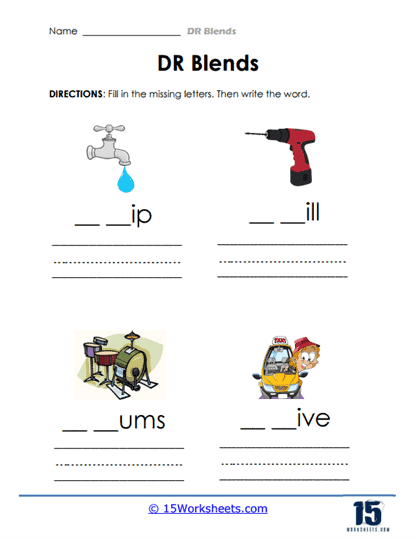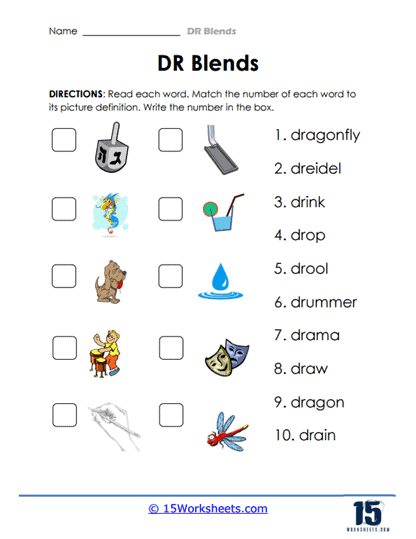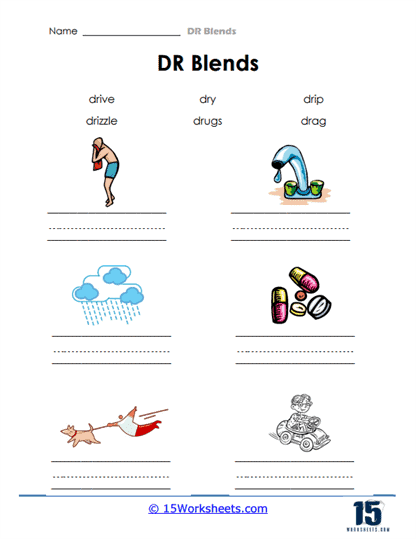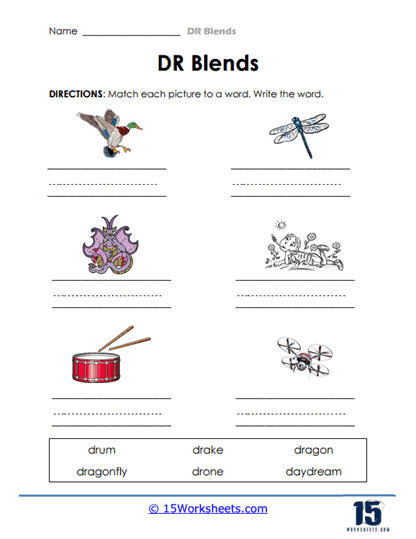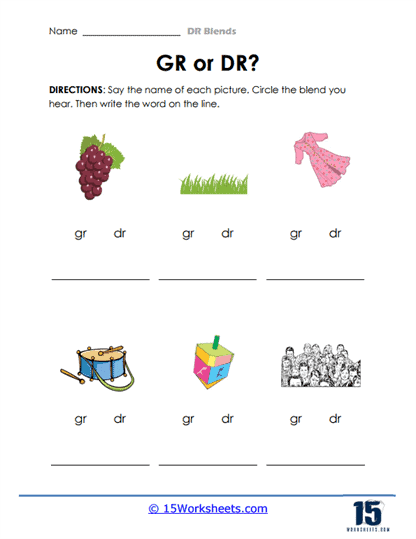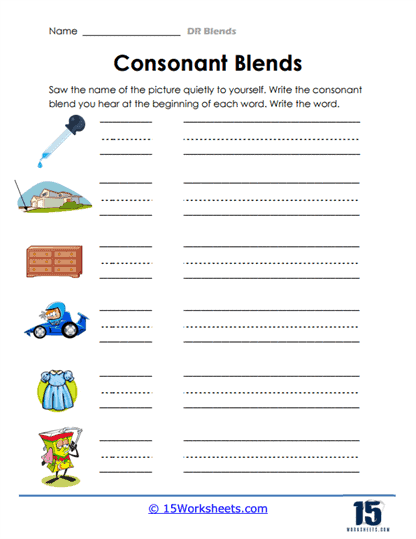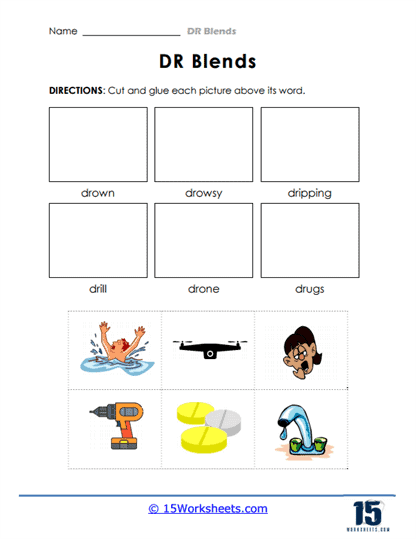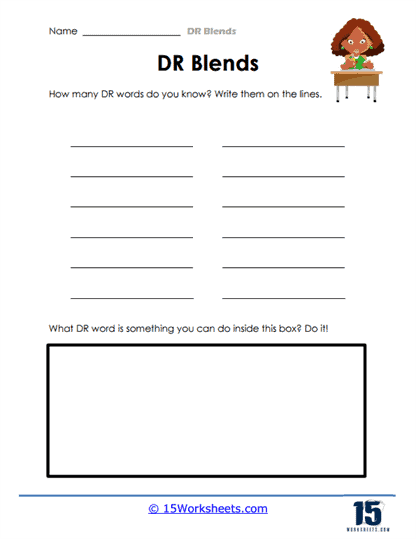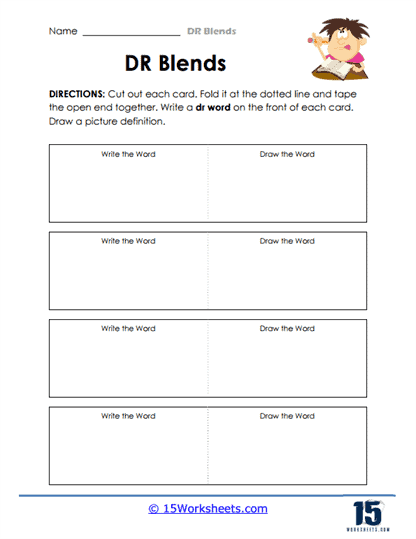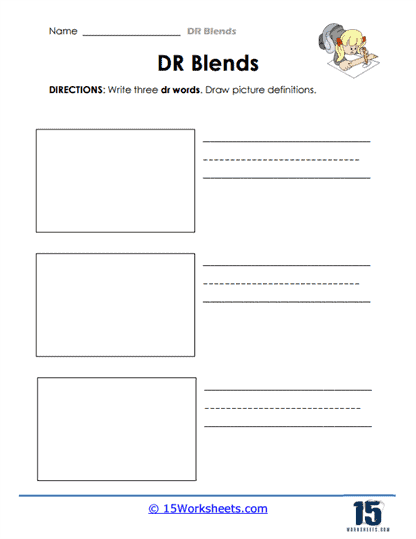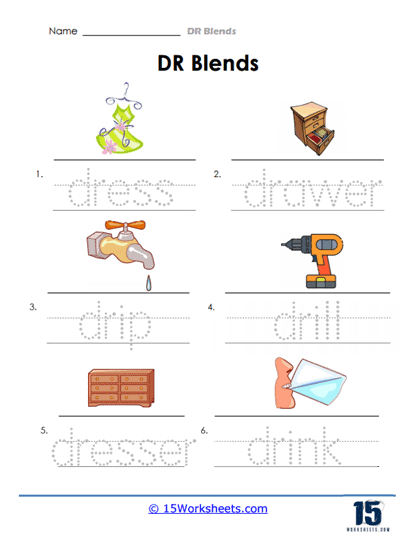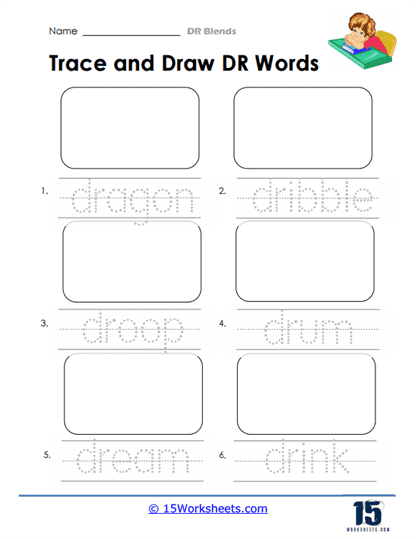DR Blends Worksheets
All About These 15 Worksheets
Phonics, the foundation of reading and language acquisition, is a crucial skill that lays the groundwork for a student’s literacy journey. Among the various aspects of phonics, consonant blends are a fundamental building block. One particular blend that students encounter frequently is the “DR” blend. This collection of DR Blends worksheets is designed to help students understand, practice, and master this blend.
Imagine you are putting together a puzzle. Each small piece joins with another to create a beautiful picture. In the world of reading, words are like puzzles, and the little pieces are sounds we call blends. One popular blend is the “DR” blend, like in “drum” or “dress.” Can you think of other words that start with “DR”?
These worksheets were designed to help students practice and learn how the “D” and “R” sounds come together to make that “DR” sound. By practicing, you get better at reading and sounding out words with this blend!
A Look At These Worksheets
Mastering consonant blends like “DR” might not sound like the stuff of legend-but this collection of DR Blends worksheets turns phonics into an unexpectedly epic journey. These 15 worksheets are cleverly crafted to target specific skills while keeping things engaging and imaginative. Students won’t just memorize blends-they’ll speak them, write them, cut them out, color them in, and maybe even giggle a little along the way. Each worksheet invites learners into a different part of the adventure, with activities grouped by the type of thinking and learning they encourage.
The journey begins with strong phonemic foundations in Fill-in Fun and Say And Write. In Fill-in Fun, students complete DR blend words by plugging in the missing pieces-think of them as junior codebreakers restoring lost “dr”s to “drum,” “drop,” and “drain.” Meanwhile, Say And Write takes a more sensory approach: learners pronounce blend words aloud before writing them down, giving both their ears and hands something to do. This multisensory reinforcement helps cement the blend sound in their memory-and it also doubles as a low-key speech warmup.
Students make crucial visual connections in Picture To Word and Word-Image Link, where they match colorful images to the correct DR words. It’s here that a dragon, a drawer, or a dripping faucet turns into a moment of clarity as kids see and say the word aloud. These worksheets tap into the natural way children learn language-through pictures, sounds, and “aha!” moments that feel less like work and more like play. It’s phonics through storytelling, with every image hinting at a DR word waiting to be discovered.
Then the worksheets turn into games-fast-paced, mind-twisting, word-scrambling fun. In Blend Swap, students manipulate parts of words to create new ones, like little language engineers rebuilding “drip” into “drop.” Pair Them Up invites them to play matchmaker between words and pictures, developing their memory and blend recognition skills. And in Word Box Challenge, the task is to find or create as many DR words as possible-think of it as a DR-themed word hunt that leaves no blend behind. These worksheets fire up problem-solving skills and make phonics feel like a puzzle to solve, rather than rules to memorize.
Auditory learners aren’t left out either. In Hearing Is Believing and Stealthy Blending, students flex their listening muscles. Hearing Is Believing presents spoken words and challenges learners to decide if the “dr” sound is present-like an audio detective game. Stealthy Blending has students slowly merge individual phonemes until a whole word emerges, making them more aware of how words are built sound by sound. It’s a quiet but powerful set of skills that help students hear language more clearly-and decode it more confidently.
The last leg of the journey gets hands-on and creative. Cut, Paste, Match!, Blend Bonanza, DIY Flashcards, and Draw To Define bring scissors, glue, imagination, and art into the mix. Whether students are matching words to pictures by snipping and sticking, making their own flashcards to quiz friends and family, or illustrating the meaning of “drizzle” and “drain,” these activities transform abstract sounds into tangible, visual learning. The act of creating deepens understanding-and adds a healthy dose of fun.
We wind down with reflective practice in Trace And Learn and Illustrating DR Blends. These worksheets slow things down and encourage students to internalize what they’ve learned. Tracing DR words reinforces handwriting and spelling, while Illustrating DR Blends invites students to show comprehension by drawing what the words mean to them. It’s a quiet, personal finish to the journey-one where students have not only learned to recognize and use DR blends but also to see them as building blocks of meaning, expression, and even creativity. In the end, these worksheets don’t just teach a sound-they give students a whole new way to listen to language.
How These Worksheets Help Students
Understanding Sounds – Phonics is all about understanding sounds in words. When you play matching games or fill in the blanks, you are training your brain to recognize and use the “DR” sound. It’s like teaching your ears to listen closely!
Building Vocabulary – The more words you know, the better reader you become. Activities like word searches or sound sorting introduce you to new words, making your word treasure chest even bigger!
Gaining Confidence – As you practice with these worksheets, you become more comfortable with “DR” words. This boosts your confidence. And when you’re confident, reading becomes easier and more fun!
Improving Memory – Games like rhyming words or writing practice are like mini workouts for your brain. They help improve your memory, so you remember words and their sounds better.
Boosting Concentration – To find hidden words or match pictures with words, you need to focus. The more you practice, the better your concentration becomes, which is a super useful skill for reading and other school subjects.
List of Common Dr- Blend Words
Drag
Draw
Drum
Dress
Drip
Drift
Dream
Dread
Dry
Drove
Drizzle
Drench
Drone
Drop
Drab
Drunk
Draft
Drama
Drastic
Drive
Drown
Drudge
Driftwood
Droplet
Drawback
Drawer
Driven
Drapes
Dragnet
Drank
The Importance of DR Blends
The “DR” blend is a combination of two consonants, ‘D’ and ‘R,’ that creates a unique sound when pronounced together. Understanding and mastering DR blends is essential for several reasons:
- Enhanced Pronunciation: Learning to pronounce DR blends correctly improves a student’s overall articulation and phonemic awareness. This, in turn, helps them speak clearly and confidently, which is a valuable life skill.
- Reading Proficiency: Many words in the English language contain DR blends. Recognizing and reading these words correctly is crucial for fluent and accurate reading. Without this skill, students may stumble over words like “dragon,” “drum,” or “dream.”
- Vocabulary Expansion: As students explore words containing DR blends, they expand their vocabulary. Exposure to a wide range of words helps them understand context and meaning, making them more proficient readers and writers.
- Spelling Proficiency: Understanding the DR blend is not limited to reading; it also plays a significant role in spelling. Students who can recognize the DR blend can spell words like “dress,” “drip,” and “drink” correctly.
This collection of DR Blends worksheets is an invaluable resource for educators and parents seeking to enhance their students’ phonics and language skills. Understanding DR blends is not just about reading and spelling; it’s about building a strong foundation for effective communication and literacy.
By mastering DR blends through these engaging worksheets, students will be better prepared for a lifetime of confident reading, writing, and speaking, giving them a significant advantage in their academic and personal lives. Invest in this collection today and watch your students flourish in their language journey.

